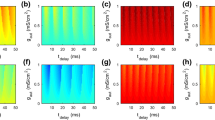Abstract
Based on the FitzHugh–Nagumo (FHN) neuron model, the effects of autapse with constant or time-periodic coupling intensity on signal transmission are investigated by calculating the Fourier coefficient Q for quantitatively characterizing the efficiency of the signal transmission. In the case of constant autaptic coupling intensity, the dependencies of Fourier coefficient Q on autaptic coupling intensity σ present bell-shaped curves and when the autaptic time delay τ is approximately multiple of the period of the sub-threshold external periodic signal, the maximums of Fourier coefficient Q are obtained at moderate autaptic coupling intensities τ. Moreover, with the increase of autaptic coupling intensity τ, autaptic time delay-induced peaks become more abruptly and narrow but the height of peaks increases.This suggests that autapse may play active roles to effectively improve the efficiency and time precision of signal transmission. In the case of autapse with time-periodic coupling intensity, when autaptic coupling intensity oscillates with appropriate speed (neither too fast nor slowly), autapse cannot significantly improve the efficiency of signal transmission, but can significantly broaden the valid ranges of parameters, implying that the plasticity of autapse may improve the adaptive capacity of neurons.
Similar content being viewed by others
References
E. Yilmaz et al., Physica A 392, 5735 (2013)
N. Caporale, Y. Dan, Annu. Rev. Neurosci. 31, 25 (2008)
H. Markram et al., Science 275, 213 (1997)
L. Wang, Y. Gong, X. Lin, Chaos Solitons Fractals 45, 131 (2012)
X. Lin, Y. Gong, L. Wang, Chaos 21, 309 (2011)
A. Bî rzu, K. Krischer, Chaos 20, 043114 (2010)
E. Yilmaz, V. Baysal, M. Ozer, Phys. Rev. A 379, 1594 (2015)
B. Xu et al., Eur. Phys. J. B 85, 299 (2012)
J. Shi, M. Luo, C. Huang, Cogn. Neurodyn. 11, 383 (2017)
B. Xu et al., Nonlinear Dyn. 72, 79 (2013)
d.L.H. Van, E.M. Glaser, Brain Res. 48, 355 (1972)
E. Yilmaz et al., Sci. Rep. 6, 30914 (2016)
A.B. Karabelasa, D.P. Purruraa, Brain Res. 200, 467 (1980)
G. Tamás, E.H. Buhl, P. Somogyi, J. Neurosci. 17, 6352 (1997)
J. Lü bke et al., J. Neuros. 16, 3209 (1996)
Y. Li et al., Phys. Rev. E 82, 061907 (2010)
S.L. Guo et al., Complexity 2017, 4631602 (2017)
Y. Xu et al., Sci. Rep. 7, 43452 (2017)
Y. Yao et al., Physica A 492, 1247 (2018)
J. Ma etal., Neurocomputing 167, 378 (2015)
H.T. Wang et al., Commun. Nonlinear. Sci. Numer. Simul. 19, 3242 (2014)
C. Wang et al., Complexity 2017, 5436737 (2017)
J. Ma, J. Tang, Nonlinear Dyn. 89, 1569 (2017)
E. Yilmaz, M. Ozer, Physica A 421, 455 (2015)
L.J. Yang et al., Phys. Rev. E 86, 016209 (2012)
C. Yao, M. Zhan, Phys. Rev. E 81, 061129 (2010)
Y. Yao, J. Ma, Cogn. Neurodyn. 12, 343 (2018)
Y. Yao, M. Yi, D. Hou, Int. J. Mod. Phys. B 31, 1750204 (2017)
Y. Yao et al., Complexity 2018, 5632650 (2018)
Author information
Authors and Affiliations
Corresponding author
Rights and permissions
About this article
Cite this article
Yao, Y., Ma, J. Signal transmission by autapse with constant or time-periodic coupling intensity in the FitzHugh–Nagumo neuron. Eur. Phys. J. Spec. Top. 227, 757–766 (2018). https://doi.org/10.1140/epjst/e2018-800008-2
Received:
Revised:
Published:
Issue Date:
DOI: https://doi.org/10.1140/epjst/e2018-800008-2



